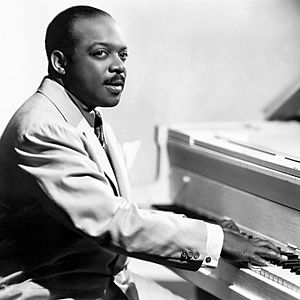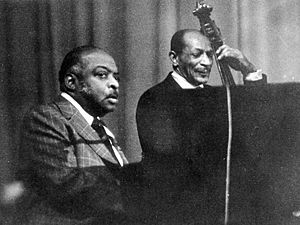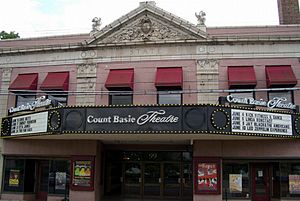Count Basie facts for kids
Quick facts for kids
Count Basie
|
|
|---|---|

Basie at the piano, 1955, in a photographic portrait by James J. Kriegsmann
|
|
| Background information | |
| Birth name | William James Basie |
| Born | August 21, 1904 Red Bank, New Jersey, U.S. |
| Died | April 26, 1984 (aged 79) Hollywood, Florida, U.S. |
| Genres | |
| Occupation(s) |
|
| Instruments |
|
| Years active | 1924–1984 |
William James "Count" Basie (August 21, 1904 – April 26, 1984) was an American jazz pianist, organist, bandleader, and composer. He started the Count Basie Orchestra in 1935. For almost 50 years, he led this famous group.
Basie brought new ideas to jazz music. He used two tenor saxophones and made the rhythm section very important. He also used "riffs" (repeated musical phrases) with his big band. Many talented musicians became famous while playing with him. These included saxophonists Lester Young and Herschel Evans, guitarist Freddie Green, and singers Jimmy Rushing and Joe Williams.
Contents
Count Basie's Life Story
Growing Up and Learning Music
William Basie was born in Red Bank, New Jersey. His father worked as a coachman and later as a handyman. Both his parents loved music. His father played the mellophone, and his mother played the piano. She even gave Basie his first piano lessons.
Basie was a good student. He dreamed of traveling, inspired by carnivals that visited his town. He spent a lot of time at the Palace Theater in Red Bank. Doing small jobs there let him watch performances for free. He quickly learned to play music for the acts and silent movies.
Basie was naturally good at the piano. But he first preferred playing the drums. When he saw how talented Sonny Greer was, Basie decided to focus only on the piano at age 15. Greer later became Duke Ellington's drummer. Basie played with local groups for dances and shows. He also learned about upcoming jobs from other musicians.
Starting His Music Career
Around 1920, Basie moved to Harlem, a very important place for jazz music. He met Sonny Greer there, who was already playing with Duke Ellington's band. Basie soon met many other Harlem musicians, like Willie "The Lion" Smith and James P. Johnson.
From 1925 to 1927, Basie toured with different shows. He played as a solo pianist and also with blues singers. His tours took him to cities like Kansas City, St. Louis, and Chicago. He met many jazz musicians, including Louis Armstrong. These early tours helped him a lot in his future career.
Back in Harlem in 1925, Basie got a steady job at Leroy's. This place was known for its piano players and "cutting contests." These were musical challenges where pianists tried to outplay each other. He also met Fats Waller, who taught him how to play the organ. Willie "the Lion" Smith also helped Basie during tough times. He found him gigs and taught him piano techniques.
In 1928, Basie heard Walter Page and his Famous Oklahoma City Blue Devils. This was one of the first big bands. Soon after, Basie was asked to join the band. It was around this time that he started being called "Count" Basie.
Kansas City Jazz
In 1929, Basie joined the Bennie Moten band in Kansas City. Moten wanted his band to be as good as those led by Duke Ellington. The Moten band played in the "Kansas City stomp" style. Basie played piano and helped arrange the music.
Their song "Moten Swing" was very important for the development of swing music. The band became very popular. Basie sometimes played piano with Moten, who also conducted. The band got even better with new members, like saxophonist Ben Webster.
After Moten passed away in 1935, Basie formed his own nine-piece band. He called them the Barons of Rhythm. Many former Moten members joined him, including Walter Page (bass), Freddie Green (guitar), Jo Jones (drums), Lester Young (tenor saxophone), and Jimmy Rushing (vocals).
The Barons of Rhythm often played at the Reno Club. Their performances were sometimes broadcast on local radio. One night, the announcer wanted to give Basie a special name. He called him "Count," placing him alongside other famous jazz musicians like "Duke" Ellington.
Basie's new band played at the Reno Club. One night, they had extra time to fill. The band started improvising, and Basie loved it. He named the song "One O'Clock Jump." It became his most famous tune.
First Recordings and New York

In late 1936, Count Basie and His Barons of Rhythm moved to Chicago. They played for a long time at the Grand Terrace Ballroom. Basie's band was known for its strong rhythm section. He also used two tenor saxophone players, which was new at the time. This idea was later copied by many other bands.
In October 1936, the band had a recording session. The producer, John Hammond, called it a "perfect" recording session. These were some of Lester Young's first recordings. The songs were released under the name Jones-Smith Incorporated.
By 1937, Basie's music had a "jumping" beat and his unique piano style. His band included talented musicians like Lester Young, Freddie Green, and Jo Jones. Lester Young gave nicknames to everyone in the band. He called Basie "Holy Man."
Basie loved the blues and often featured famous blues singers. These included Billie Holiday, Jimmy Rushing, and Helen Humes. He also hired arrangers to help the band sound even better.
When Basie's orchestra moved to New York in 1937, they made the Woodside Hotel their home base. They soon played at the Roseland Ballroom. At first, Basie's band was not as polished as other famous bands.
John Hammond helped the band improve. They learned to play softer, add more solos, and save their best songs for later in the show. Their first official recordings for Decca included "Pennies from Heaven" and "Honeysuckle Rose".
Hammond also introduced Basie to Billie Holiday, who sang with the band. The band played at the Apollo Theater, where Holiday and Jimmy Rushing were very popular. The orchestra often worked out their songs in rehearsal without written music. They remembered the "head arrangements" and played them from memory.
Basie's band later played at the Savoy Ballroom. In early 1938, they had a famous "battle of the bands" with Chick Webb's group. Basie had Billie Holiday, and Webb had Ella Fitzgerald. Basie's band won the battle, which made them even more famous. Soon after, Benny Goodman recorded Basie's song "One O'Clock Jump".
A few months later, Helen Humes joined Basie's band as a singer. The band started playing at the Famous Door, a popular nightclub. Their fame grew a lot. In 1939, Basie and his band went on a big tour across the country. They also signed with a new agency that got them better pay.
During the 1940s, the band continued to tour and record. They appeared in several movies, like Stage Door Canteen (1943) and Blazing Saddles (1974). World War II caused some changes in the band members. Bookings for dance halls went down as swing music became less popular. But Basie always kept a big band with a great rhythmic beat and talented soloists.
Later Years and New Sounds
After the war, the big band era seemed to end. Basie broke up his large group for a while and played in smaller combos. In 1952, he formed a 16-piece orchestra again. This group was called the New Testament band. Basie said that singer Billy Eckstine encouraged him to bring back the big band.
This new band played at the Birdland club and made new recordings. The jukebox era had begun, and Basie's music was heard alongside early rock'n'roll and rhythm and blues artists. The New Testament band focused more on written arrangements and less on solos.
Basie added some bebop elements to his music, but always kept his strong rhythmic pulse. He also added the flute to some songs, which was new at the time. Soon, his band was touring and recording again. In 1958, the band went on its first European tour. Jazz was very popular in Europe.
In 1957, Basie released the live album Count Basie at Newport. His song "April in Paris" became a best-selling instrumental. The Basie band also performed for Queen Elizabeth II in the British Isles. Basie appeared on TV shows and recorded a "greatest hits" album.
In 1961, Basie performed at one of John F. Kennedy's Inaugural Balls. That summer, Basie and Duke Ellington recorded an album together called First Time! The Count Meets the Duke. Throughout the 1960s, the band stayed busy with tours, recordings, and TV appearances. Basie continued to lead the band into the 1980s.
Family Life
On July 13, 1940, Basie married Catherine Morgan. In 1942, they moved to Queens, New York. Their only child, Diane, was born in 1944. Diane was born with cerebral palsy, but her parents cared for her deeply. With her mother's help, Diane learned to walk and swim. The Basies bought a home in St. Albans, Queens, in 1946.
Catherine Basie passed away in 1983. Count Basie died from pancreatic cancer in Hollywood, Florida, on April 26, 1984, at age 79.
Famous Singers He Worked With
Basie worked with many famous singers in the 1950s and 1960s. This helped keep the Big Band sound popular. Jimmy Rushing sang with Basie in the late 1930s. Joe Williams toured with the band and had a huge hit with "Every Day (I Have the Blues)".
Ella Fitzgerald made memorable recordings with Basie, including the 1963 album Ella and Basie!. She even toured with his orchestra. They also recorded together in 1979. Basie also worked with arrangers like Neal Hefti and Sammy Nestico.
Frank Sinatra recorded with Basie for the first time in 1962 on Sinatra-Basie. They made another studio album in 1964 and a live album in 1966. Sinatra later said a concert he did with Basie in London was one of his "finest hour[s]".
Basie also recorded with Tony Bennett, Sammy Davis Jr., Bing Crosby, and Sarah Vaughan. One of Basie's biggest regrets was never recording with Louis Armstrong, even though they performed together many times.
Count Basie's Legacy and Awards
Count Basie introduced many people to the Big Band sound. He left behind a very important collection of music. People who worked with him remember him as kind, humble, and always excited about his music. He once wrote that a band truly "swings" when it plays "easy."
Many places and honors are named after him:
- In his hometown of Red Bank, New Jersey, the Count Basie Theatre and Count Basie Field are named in his honor.
- Mechanic Street, where he grew up, is now called Count Basie Way.
- In New York City, a street corner where he lived was renamed Count Basie Place.
- In 2010, Basie was added to the New Jersey Hall of Fame.
- In 2019, he was inducted into the Blues Hall of Fame.
- An asteroid, 35394 Countbasie, was named after him in 2019.
- He has a star on the Hollywood Walk of Fame in Hollywood, California.
Basie in Movies and Music
Count Basie's music has been used in many other places:
- Jerry Lewis used "Blues in Hoss' Flat" for his routine in the movie The Errand Boy.
- The song "Blues in Hoss' Flat" was also a theme song for a radio DJ.
- In the movie Home Alone 2: Lost in New York (1992), a character mentions hearing Basie play.
- Drummer Neil Peart of the band Rush played a version of "One O'Clock Jump" in his drum solos.
- "The Kid From Red Bank" has been the theme song for a popular Norwegian radio show since 1963.
- In the 2016 movie The Matchbreaker, a character tells a story about how Count Basie met his wife.
- The band Dance Gavin Dance has a song called "Count Bassy."
- In the 2021 movie “Elvis,” a Count Basie poster can be seen.
Awards and Recognitions
Count Basie won many awards for his music. In 1958, he became the first African-American to win a Grammy Award.
| Count Basie Grammy Award history | ||||
| Year | Category | Title | Genre | Results |
|---|---|---|---|---|
| 1984 | Best Jazz Instrumental Performance, Big Band | 88 Basie Street | Jazz | Winner |
| 1982 | Best Jazz Instrumental Performance, Big Band | Warm Breeze | Jazz | Winner |
| 1980 | Best Jazz Instrumental Performance, Big Band | On The Road | Jazz | Winner |
| 1977 | Best Jazz Performance by a Big Band | Prime Time | Jazz | Winner |
| 1976 | Best Jazz Performance by a Soloist (Instrumental) | Basie And Zoot | Jazz | Winner |
| 1963 | Best Performance by an Orchestra – For Dancing | This Time By Basie! Hits of the 50's And 60's | Pop | Winner |
| 1960 | Best Performance by a Band For Dancing | Dance With Basie | Pop | Winner |
| 1958 | Best Performance by a Dance Band | Basie (The Atomic Mr. Basie) | Pop | Winner |
| 1958 | Best Jazz Performance, Group | Basie (The Atomic Mr. Basie) | Jazz | Winner |
His recordings have also been added to the Grammy Hall of Fame. This award honors recordings that are at least 25 years old and are very important.
| Count Basie Grammy Hall of Fame Awards | ||||
| Year recorded | Title | genre | Label | Year inducted |
|---|---|---|---|---|
| 1939 | Lester Leaps In | Jazz (Single) | Vocalion | 2005 |
| 1955 | Everyday (I Have the Blues) | Jazz (Single) | Clef | 1992 |
| 1955 | April in Paris | Jazz (Single) | Clef | 1985 |
| 1937 | One O'Clock Jump | Jazz (Single) | Decca | 1979 |
In 1985, after his death, Count Basie was given the Presidential Medal of Freedom. This is one of the highest awards a civilian can receive in the United States. In 1996, the U.S. Post Office issued a stamp with his picture.
| Count Basie award history | ||||
| Year | Category | Result | Notes | |
|---|---|---|---|---|
| 2019 | Blues Hall of Fame | Inducted | ||
| 2007 | Long Island Music Hall of Fame | Inducted | ||
| 2005 | Nesuhi Ertegun Jazz Hall of Fame | Inducted | ||
| 2002 | Grammy Lifetime Achievement Award | Winner | ||
| 1983 | NEA Jazz Masters | Winner | ||
| 1981 | Grammy Trustees Award | Winner | ||
| 1981 | Kennedy Center Honors | Honoree | ||
| 1982 | Hollywood Walk of Fame | Honoree | at 6508 Hollywood Blvd. | |
| 1970 | Phi Mu Alpha Sinfonia | Initiated | Mu Nu Chapter | |
| 1958 | Down Beat Jazz Hall of Fame | Inducted | ||
In 2005, his song "One O'Clock Jump" was added to the Library of Congress National Recording Registry. This means it is considered very important culturally or historically.
Count Basie's Music Albums
Count Basie made most of his albums with his big band. You can find more details at Count Basie Orchestra Discography.
Here are some of his albums:
- The Swinging Count!, (Clef, 1952)
- The Atomic Mr. Basie (Roulette, 1958)
- Memories Ad-Lib with Joe Williams (Roulette, 1958)
- Basie/Eckstine Incorporated with Billy Eckstine (Roulette 1959)
- String Along with Basie (Roulette, 1960)
- Count Basie and the Kansas City 7 (Impulse!, 1962)
- Basie Meets Bond (United Artists, 1966)
- Basie's Beatle Bag (Verve, 1966)
- Basie on the Beatles (Verve, 1969)
- Basie Jam (Pablo, 1973)
- The Bosses with Big Joe Turner (1973)
- For the First Time (Pablo, 1974)
- Satch and Josh with Oscar Peterson (Pablo, 1974)
- Basie & Zoot with Zoot Sims (Pablo, 1975)
- Basie Jam 2 (Pablo, 1976)
- Basie Jam 3 (Pablo, 1976)
- The Gifted Ones with Dizzy Gillespie (Pablo, 1977)
- Montreux '77 (Pablo, 1977)
- 88 Basie Street (Pablo, 1983)
Movies Count Basie Appeared In
- Hit Parade of 1943 (1943) – as himself
- Top Man (1943) – as himself
- Sugar Chile Robinson, Billie Holiday, Count Basie and His Sextet (1950) – as himself
- Jamboree (1957)
- Cinderfella (1960) – as himself
- * and the Single Girl (1964) – as himself with his orchestra
- Blazing Saddles (1974) – as himself with his orchestra
- Last of the Blue Devils (1979) – interview and concert in a documentary
Images for kids
-
Basie and band, with vocalist Ethel Waters, from the film Stage Door Canteen (1943)
See also
 In Spanish: Count Basie para niños
In Spanish: Count Basie para niños









